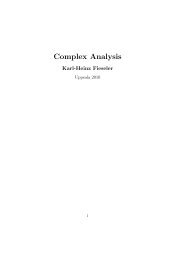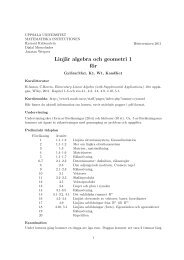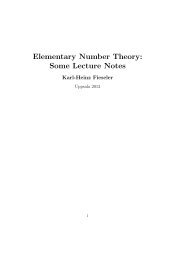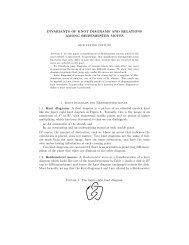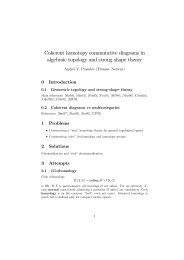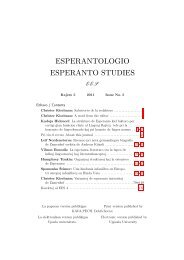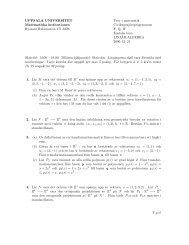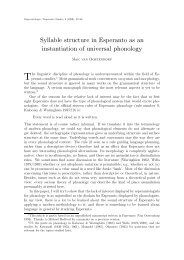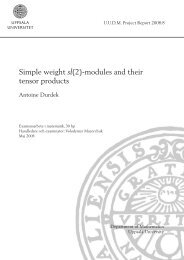Malmsten's Proof of the Integral Theorem
Malmsten's Proof of the Integral Theorem
Malmsten's Proof of the Integral Theorem
- No tags were found...
You also want an ePaper? Increase the reach of your titles
YUMPU automatically turns print PDFs into web optimized ePapers that Google loves.
property <strong>of</strong> being two telescoping sums which in <strong>the</strong> limit becomes <strong>the</strong> clockwiseintegration above. The counter clockwise integral is reached via a similarapproach.In more detail, <strong>the</strong> sum can be written asS n =r=n ∑r=1[(x r − x r−1 )p(x r−1 , y r−1 ) + (y r − y r−1 )q(x r−1 , y r−1 )] ,and each term can be rewritten as∫ xrx 0(x r − x r−1 )p(x r−1 , y r−1 ) + (y r − y r−1 )q(x r−1 , y r−1 ) =∫ xr−1∫ yrp(x, y r )dx− p(x, y r−1 )dx+ q(x 0 , y)dy+(x r −x r−1. )λ r +(y r −y r−1 )σ r ,x 0y r−1where λ r and σ r are error terms approaching 0 in <strong>the</strong> limit. To prove thisequality Malmsten makes several calculations with Riemann-sums, makesuse <strong>of</strong> <strong>the</strong> mean value-<strong>the</strong>orem for integrals and uses expression (7) in differentialform. He does use <strong>the</strong> fact that <strong>the</strong> functions are continuous, althoughhe doesn’t mention (or realize) it. For instance he writes“Men nu är tillika(y r − y r−1 )[q(x 0 , y r−1 ) + γ r ] =∫ yry r−1q(x 0 , y)dy + (y r − y r−1 )σ ′ r(der σ ′ r convergerar mot 0 på samma gång som differenserna(17)), hvilket insatt...”This equality can be achieved by applying <strong>the</strong> mean value-<strong>the</strong>orem for integralson <strong>the</strong> right hand side integral and using continuity for <strong>the</strong> functionq when substituting a value c (from <strong>the</strong> mean-value <strong>the</strong>orem for integrals)between y r−1 and y r with y r−1 . Consequently this gives rise to an error termthat is added to σ ′ r producing a new error term γ r which converges to 0 in<strong>the</strong> limit. This is only one <strong>of</strong> several passages where ’common knowledge’<strong>the</strong>orems toge<strong>the</strong>r with <strong>the</strong> conditions <strong>of</strong> <strong>the</strong> pro<strong>of</strong> is used.Although Malmsten had come up with <strong>the</strong> condition (7), he didn’t useit in Greens formula. Probably he didn’t know about it, even though it waspublished by W. Thompson (Lord Kelvin) in Crelle’s Journal in 1850 [2].In fact, George Green (1793-1841) had published it, at his own expense, asearly as 1828 [2]. But <strong>the</strong> fact that Green was a physicist toge<strong>the</strong>r with alacking communication may have been some <strong>of</strong> <strong>the</strong> reasons why <strong>the</strong> <strong>the</strong>oremremained unknown for more than 20 years.16




